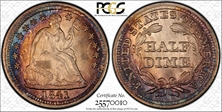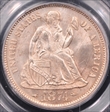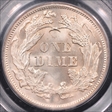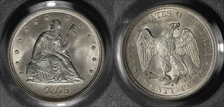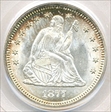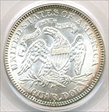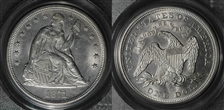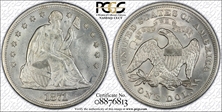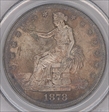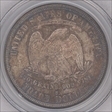Goldbrecht's Raisinet Collection 的钱币相册
1841 H10C MS67 V-2 Mintage: 50,000. The last 1 in the date is low and recut, and a small lunule appears between stars 10 and 11. Sharply struck, this is an extraordinarily well-preserved Superb Gem of this type, with full original luster and an exemplary strike, struck from moderately clashed dies. The surfaces emit a warm glow, with lightly toned, golden-rose centers and rich golden-brown, mauve and cobalt-blue peripheral colors about the rims. This second year of the Drapery sub-type is more available than its introductory 1840 counterpart, but relatively few pieces have been certified by PCGS in Mint State grades. Among half dime collectors the 1841 is considered a common date, but it certainly is uncommon in MS67 condition. VARIETIES: V-1 (Proof only). V-2 and V-3 represent variations of the date replacement. There is also a repunched date (RPD) variety with a repunched 1 at the top, and a reverse with heavy lettering designated V-4. The V-2 in late die states exhibits a significant die crack running diagonally from 2 to 7 o’clock. Evidencing not a hint of a crack, this piece would seem to be an example of a much earlier die state. The V-2 variety usually is strongly struck, other than minor weakness of dentils on the reverse, with a full head, shield and toe. The date and stars are boldly punched. The pendant lines up just right of the upright of the 4, and the shield points to the top of the 1.
1841 H10C MS67 V-2 Mintage: 50,000. The last 1 in the date is low and recut, and a small lunule appears between stars 10 and 11. Sharply struck, this is an extraordinarily well-preserved Superb Gem of this type, with full original luster and an exemplary strike, struck from moderately clashed dies. The surfaces emit a warm glow, with lightly toned, golden-rose centers and rich golden-brown, mauve and cobalt-blue peripheral colors about the rims. This second year of the Drapery sub-type is more available than its introductory 1840 counterpart, but relatively few pieces have been certified by PCGS in Mint State grades. Among half dime collectors the 1841 is considered a common date, but it certainly is uncommon in MS67 condition. VARIETIES: V-1 (Proof only). V-2 and V-3 represent variations of the date replacement. There is also a repunched date (RPD) variety with a repunched 1 at the top, and a reverse with heavy lettering designated V-4. The V-2 in late die states exhibits a significant die crack running diagonally from 2 to 7 o’clock. Evidencing not a hint of a crack, this piece would seem to be an example of a much earlier die state. The V-2 variety usually is strongly struck, other than minor weakness of dentils on the reverse, with a full head, shield and toe. The date and stars are boldly punched. The pendant lines up just right of the upright of the 4, and the shield points to the top of the 1.
1874 10C Arrows MS66. Light orange toning visits the primarily silver-white surfaces. This Premium Gem is lustrous and well struck, and both sides are splendidly unabraded. The second and final year of the Arrows, Legend Obverse subtype. Housed in a green label holder.
1874 10C Arrows MS66. Light orange toning visits the primarily silver-white surfaces. This Premium Gem is lustrous and well struck, and both sides are splendidly unabraded. The second and final year of the Arrows, Legend Obverse subtype. Housed in a green label holder.
1875-S 20C MS65. Although San Francisco struck more than 1.1 million twenty cent coins in 1875, the facility passed on production of the denomination in 1876, the only other year it was struck for circulation rather than collector sales. The Specie Redemption Act, passed on Jan. 14, 1875, mandated that as of Jan. 1, 1879, gold coins would be exchangeable at par with paper bills--for the first time since the end of 1861. This ensured that paper currency of one dollar or more would be backed by gold, and that the government would gradually reduce the number of "greenbacks" in circulation. Western silver miners, who had been increasing in wealth, power, and political influence in the 1870s, wanted more. The silver twenty cent piece was introduced in that same year, even though it was confusingly similar in size and design to the quarter (the Susan B. Anthony dollar was still far in the future). The brief production of the Twenty Cent piece seems rather predictable today. The ill-conceived denomination was a dismal failure in terms of practicality, being neither needed nor wanted. However little sense it makes to have a One Cent coin today, it made even less to push a Twenty Cent coin down the public's throat in the 1870s. Nevertheless, the expanding economy in the Far West was so strong during this period and the need for small silver coinage so great that even this albatross managed to circulate rather extensively. Still, the novelty of this first year issue and its comparatively high production of over 1.1 million pieces meant that a fair number were set aside for posterity, perhaps several thousand coins in total. The typical 1875-S in Mint State has been rather carelessly preserved or poorly produced, often displaying substandard luster and noticeable softness on the major design elements (particularly the eagle's left wingtip). As a result most fall into the MS62-63 grade range and it is unusual to find an example that surpasses the Choice level. This is a beautiful, richly toned Gem of this popular type coin from the generous first-year S-mint production (it is not a coincidence that most twenty cent pieces were made in the West, at both San Francisco and Carson City). The surfaces are simply excellent, with plenty of underlying luster. Light aquamarine and gold toning enriches this example, which is very well-struck save for a few right-side stars. The viewer immediately notices the thick mint frost on this piece, which is all the more remarkable considering the presence of the toning.
1877 25C MS66. Type Two Reverse. The 1877 Seated Liberty quarter is more difficult to locate than the mintage of nearly 11 million pieces would suggest. Many examples were melted in 1878 to provide silver bullion for Morgan dollars. The present coin is a well-struck Premium Gem, with lustrous surfaces and gold and violet highlights. The reverse displays extensive die cracks and clash marks.
1877 25C MS66. Type Two Reverse. The 1877 Seated Liberty quarter is more difficult to locate than the mintage of nearly 11 million pieces would suggest. Many examples were melted in 1878 to provide silver bullion for Morgan dollars. The present coin is a well-struck Premium Gem, with lustrous surfaces and gold and violet highlights. The reverse displays extensive die cracks and clash marks.
1884 50C Repunched Date, WB-102, MS66 PCGS. The motto IN GOD WE TRUST was added to the reverse of Seated Liberty coinage in 1866. Although the Civil War ended in 1865, the resumption of specie payments would have to wait for the passage of the Mint Act of February 12, 1873. As such, deliveries of half dollars from 1866-1873 remained low with the exception of a few S-mint issues. The first-year the Motto Half Dollar was produced was 1866, but only to the extent of only 745,625 pieces versus the 3.2 million pieces that were struck of the 1875-S. The P-mint Seated halves from 1879 to 1890 have tiny mintages, as series specialists can attest. This is due primarily to the millions of Morgan dollars that the Philadelphia Mint pumped out with annual celerity, mandated by the Bland-Allison Act. Mintages of Seated half dollars from 1879 to 1890 ranged from 4,400 to 12,001 business strikes per year. Of them all, the 1882 and 1884 mintages are tied for the smallest—4,400 pieces each year—as sufficient quantities of half dollars were in circulation. In effect, the paltry production makes every coin a first-strike representative, hence the larger proportion of markedly proof-like survivors. This popular issue has one of the smallest mintages in not only the Seated half dollar series, but all half dollar series from 1794 to present. Judging by the certified population data, collectors and/or the general public were certainly aware of the tiny mintages, as the numbers extant today are several times the typical surviving population. Of the 4,400 business-strike Seated Liberty half dollars struck in 1884, some of the rare high-grade examples, like the present coin, show deeply reflective proof-like fields. A spectacular gem example of this low mintage, late date Seated half, it is fully struck and the design elements are sharply detailed. The strike is razor-sharp throughout and tiny, well-concealed marks fail to distract. Originality is a hallmark of both sides. Rich toning in shades of cobalt-blue, violet, red, and golden-amber enhance the visual quality of this remarkable Premium Gem, forming a beautiful halo around untoned centers. The thickly frosted portraits of Liberty and the eagle generate significant, albeit undesignated proof-like contrast against the partly mirrored fields. The reverse fields are essentially fully proof-like. This toned, proof-like piece has high field-device contrast and only the most minor distractions. Highly reflective luster adds to the wonderful eye appeal of this superb coin, an exemplary 1884 half. Variety WB-102 with a Recut 4, struck from the business-strike die, the present coin shows minor recutting on the base of the 4. All circulation strikes show the 4 slightly recut north. A business strike-only die pairing, and one of only two, the other being the rare variant with the top of an errant 8 in the denticles beneath the 8 and 4. Provenance: Larry Whitlow
1871 Liberty Seated Dollar MS-63. Brilliant white, intensely frosty and choice for the grade. The blast of snow-white color comes with a change to more subtle frost on the main devices. The only weak area in the strike is seen at a few obverse stars.
1871 Liberty Seated Dollar MS-63. Brilliant white, intensely frosty and choice for the grade. The blast of snow-white color comes with a change to more subtle frost on the main devices. The only weak area in the strike is seen at a few obverse stars.
1871 Liberty Seated Dollar MS-63. Brilliant white, intensely frosty and choice for the grade. The blast of snow-white color comes with a change to more subtle frost on the main devices. The only weak area in the strike is seen at a few obverse stars.
1878-S T$1 MS64+. The 1878-S Trade dollar enjoyed a large mintage of 4.1 million pieces, and the date is readily available in most grades today. However, examples in Choice condition are scarce, and higher-grade pieces are rare. The present coin displays nice toning, with an iridescent violet and golden-brown patina, and ample frosty mint luster and sharply detailed devices.
1878-S T$1 MS64+. The 1878-S Trade dollar enjoyed a large mintage of 4.1 million pieces, and the date is readily available in most grades today. However, examples in Choice condition are scarce, and higher-grade pieces are rare. The present coin displays nice toning, with an iridescent violet and golden-brown patina, and ample frosty mint luster and sharply detailed devices.





















